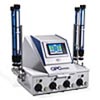| Chromatography Corner |
|
An Emerging Leader: One Year Later
This month’s Chromatography Corner features an interview with Jared Anderson, Associate Professor of Chemistry at the University of Toledo and the 2010 recipient of LCGC’s Emerging Leader Award.
More... |
| |
NEW 2011 Waters Quality Parts, Chromatography Columns and Supplies Catalog Now Available
Explore the new 2011/12 Waters “Quality Parts, Chromatography Columns, and Supplies Catalog.” For the first time available as digital, print, and PDF formats, this catalog can be used in the version you find most convenient wherever you are. Combined with the new “Order Center,” the digital catalog format allows you to easily find your vials, columns, or SPE devices just by clicking on the part numbers.
 Read more... Read more...
|
|
| |
| Featured Application Note |
|
|
| |
| Market Profile |
|
Capillary Electrophoresis
Capillary electrophoresis (CE), introduced in the 1980s, utilizes the same principles as gel electrophoresis for the qualitative and quantitative analysis of charged biological molecules, including proteins, carbohydrates, and nucleic acids as well as inorganic compounds.
More...
|
| |
Learn how autosampler vials can cause data errors
“I think I need RSA Glass,” may be your first thought after learning how “common” auto-sampler vials can be the source of your sample problems and nonreproducing results. The presence of “silanols,” metals, and common contaminants found on the surface of borosilicate glass vials can adsorb basic compounds and cause hysteresis and pH changes. RSA™ has virtually no silanols or metals and is contaminant free; eliminating common vial problems.
 Read more... Read more...
|
|
| |
| Featured Products |
|
GPC Quattro Sample Clean-up
Synchronized processing on four columns or four separate programs on each column maximizes your throughput and flexibility. The GPC Quattro is manual inject matched with robust functions and reproducible high recoveries. 
Read more... |
|
 |
|
| |
Wyatt Technology’s New Möbius
To measure electrophoretic mobility and zeta potential of proteins, nanoparticles and macromolecules as small as 1 nm, we crank up the sensitivity. Sadly, others crank up the voltage.
 Read more... Read more... |
|
 |
|
| |
|
|
|
|


